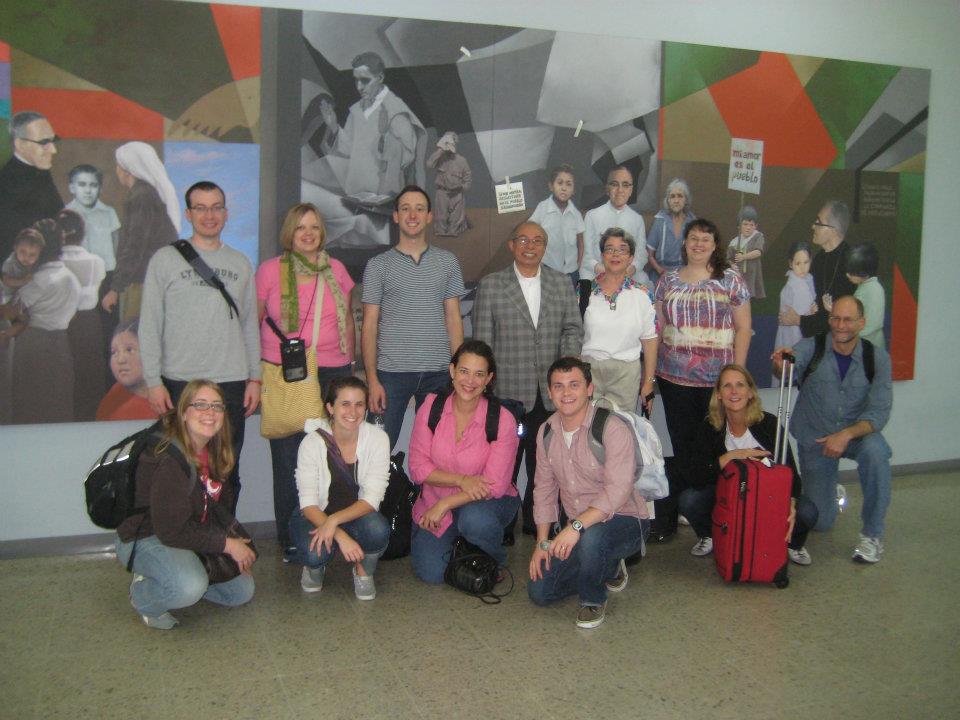Just the other day my son Sam said to me, “Hey Mom, tell me a knock knock joke!” I was game, of course, so I complied. “Knock knock,” I said. “Who’s there?” He answered.
And then…nothing.
I wasn’t sure what to say.
Since I asked the question, it was my job to follow up with the actual joke, which of course I did not have ready. I wasn’t paying close enough attention, as usual, and I was tricked.
Sam thought it was hilarious.
It’s a very good thing that Jesus was smarter than I am, because in our Gospel passage today Jesus was asked a question asked for the sole purpose of tricking him, but he didn’t fall for it. Instead, he gave the people listening to him in the crowd that day…and he gave us…a deep and profound challenge to consider, the challenge of asking ourselves to what or to whom we cede our allegiance, who it is exactly who rules our lives.
Our lectionary passage today continues in the Gospel of Matthew, chapter 22. Within the context of the Gospel story, it will be helpful to remember that all the passages we’re reading during these three weeks of stewardship come from Matthew’s account of Jesus’ last week. In chapter 21, in fact, Jesus comes into the city to a public demonstration of palm waving and admirers calling him king. If the Jewish leaders and the Roman authorities weren’t worried about him before then, they certainly were after that. That demonstration only ramped up the anxiety and whatever plans the Pharisees and other Jewish leaders had to get rid of Jesus surely swung into full gear. In other words, things were tense.
The way Matthew describes that week, though, it seems like Jesus was only fanning the flames of a potentially very big and very dangerous fire. He went around Jerusalem teaching, as was his custom, but he was telling stories that were inflammatory and surely helped to raise the tension even more. It wasn’t really that he was saying anything different than he’d always been saying, it was just that the revolutionary nature of his message had somehow begun to be planted in the hearts of the people. They were listening very carefully to what he had to say. They were beginning to see that a living faith changed everything about the lives they lived day in and day out.
And this shift of public opinion was not a good one from the perspective of the religious leaders. If people started interpreting faith as a call to justice, to peace, to a world in which all people are valued and where power is used for peacemaking and the healing of inequalities…well, that might result in a serious inability to control the masses. The people who had the power were not amused, in other words. In fact, they were alarmed.
If I were Jesus, I would think that this state of affairs might call for a strategy like…getting out of Jerusalem, going underground, hiding for a bit, at least until things calmed down a little. Don’t you think?
Well, Jesus did not take this approach. Instead, at least in Matthew’s memory of the way things unfolded, Jesus was very visible—hanging out in public places around Jerusalem, telling parables that were only making an already incendiary situation much more explosive. You recall that he’d gone to the temple and turned over the tables of the money changers. He was telling parables about wicked tenants and a wedding banquet open to everyone, not just the special people. And none of this was helping Jesus divert attention away from himself. Crowds followed him everywhere; people were hanging on every word.
It was in this touchy situation that the Jewish religious leaders—all different factions—joined forces and decided their best bet to discredit Jesus was going to be to ask him a trick question—to catch him up in public—to watch him trip over his own feet in front of everyone. If they could manage that, well, then, they felt sure that the adoring public would realize Jesus’ message was not worth believing.
Once they settled on that strategy, they decided that the perfect trick question would certainly be a question on the topic of taxes. Nobody I know particularly likes paying taxes, but in the climate of Jerusalem the week before Jesus was crucified, the topic of taxation was especially controversial. You remember that Jerusalem was occupied by the Roman government. And all the Jews who lived in the region had to pay punishing taxes: there were taxes to the government of Rome; taxes like land and custom taxes, to Herod, their local Roman leader; and a temple tax to support the religious community and practice in Jerusalem. One commentator says that things were so tense when it came to required taxes that, if a Galilean farmer were to pay what was expected of him, he would surely have very, very little left over to support his family. The oppressive tax requirements of the government, in other words, would send an average citizen into financial ruin.
The Jewish leaders’ trick question then, as you see, had nothing to do with lofty theories of government policy or separation of church and state or even the ethics of taxation. Their question touched on an issue of survival for most of the folks in that crowd. The people listening that day were utterly crippled under the heavy, heavy burden of the taxes they had to pay and the desperation they felt as they tried to provide for their families and meet government expectations, too. As the pressure of taxation increased and they found themselves wondering whether their children would eat, you can see that any conversation about taxation would be controversial. And a good riot was exactly what they needed to take care of Jesus, that troublemaker.
So they crafted the question very carefully. After pretending to show deference to Jesus, calling him “teacher”—a sign of respect—even though they really didn’t mean it, they asked: “What do you think, Jesus? Is it lawful to pay taxes to the emperor or not?”
This was a really, really good trick question…some might say the perfect trick question. Not only was the topic of taxation a controversial one, the question as they posed it was a lose/lose question…a trick question! If Jesus said YES, one should pay taxes to the emperor, then it would have been obvious to everyone there that Jesus was an agent of the state—that his messages of freeing relationship with God and the end of oppression for all the people were empty, meaningless platitudes. They would quickly become tired of listening to him, because they would know he was just like all the other power-grabbing public figures, who said one thing but did another.
On the other hand, if Jesus said NO—you shouldn’t pay taxes, they are unlawful and discriminatory, then the Roman government would do the distasteful work of getting rid of Jesus for them. To go around suggesting that a Roman tax was unlawful, see, put Jesus in the camp of the seditious rabble rousers who were trying to stir an uprising against the Roman occupation of the region, and Rome would never let that continue.
Jesus was caught between a rock and a hard place—either way he answered he’d be in trouble. See what I mean? The perfect trick question!
But did you hear his answer? It was genius!
Jesus not only successfully deflected a question, a one-sided answer to which would not have helped dialogue, but he also gave those who were listening a very deep and profound challenge—something they’d perhaps never considered before in all their lives.
Do you remember what he said? “Render unto Caesar that which is Caesar’s, and render unto God that which is God’s.”
Huh?
The Jewish leaders who were busy rubbing their hands together with the gleeful anticipation of sweet victory—finally—were flummoxed. This wasn’t any kind of answer they were expecting. It was an answer, even, that set the world spinning for them again and showed the crowd that Jesus had an agenda that was bigger and even more profound than any political position any of them held.
What Jesus recognized in his answer to the religious leaders was that the one whose life is ceded to God is the one who lives in two worlds—the temporal world of human society and the world governed by God’s best hopes and expectations for God’s creation. We do what we have to do to be part of the society in which we live, of course. But the one who is a true follower of God is one who understands the bigger picture: that everything we are and everything we have and everything we do…belongs to God. We live in human society contributing our part, but we offer always to God that which is rightfully God’s. And that would be, well, everything.
Go, Jesus, for catching the religious leaders in their trick questioning. But wait just a minute…the answer Jesus gave was not an easy-out, thumb your nose at the government kind of answer. No, his answer laid down the gauntlet for everybody in the crowd, and insisted that if we want to claim we live as God-followers, we have a much higher standard to meet. The way of God is a way of justice and peace, and it flies smack in the face of the world around us. If we give to God what is God’s, we might be uncomfortable or unpopular. We may have to choose a way that is not the easy way, to challenge the status quo. We will probably be sharing to a degree that not many consider smart. And, as Jesus soon demonstrated for them all, we might even be called upon to give our lives in the process.
Give to Caesar what is Caesar’s—that’s the easy part.
Give to God what is God’s? That could hurt a little bit.
As many of you know, a group of 14 Calvary folks traveled to El Salvador this past week. We got home very late last night, so all of you who were  on that plane with me and are here this morning—you get extra church attendance points (give to God what is God’s, etc.). Would you raise your hands so folks can be reminded who was on that trip?
on that plane with me and are here this morning—you get extra church attendance points (give to God what is God’s, etc.). Would you raise your hands so folks can be reminded who was on that trip?
As a group, we had a very powerful experience in El Salvador, an experience you can see and hear more about next week at the Shalom Scholarship Luncheon and Calvary’s Got Talent! show next Sunday after worship. As we talked about what we experienced, we found it difficult for all of us to sum up the full experience we had—it was so powerful and multi-layered, filled with people and places that touched our hearts and changed our minds about a lot of things we thought we knew.
I think we would all agree, however, that one very powerful moment of the week was our meeting with Merardo Gomez, the Lutheran archbishop of El Salvador. Archbishop Gomez, an old and very dear friend of Pastor Edgar’s, invited us to his office to talk with him about his life and work in El Salvador over the last 35 plus years.
The best way to describe Archbishop Gomez was voiced by Laura Canfield, who upon meeting him exclaimed, “Oh my gosh, he’s a Lutheran Pastor Edgar!” And he was. Imagine, if you will, a man who looks and sounds quite a bit like our own Pastor Edgar, except with a clerical collar. We visited with Archbishop Gomez for a couple of hours, during which he told us the very moving story of the subversive cross.
When tensions were running very high in El Salvador in the late 1980s, with the civil war in full swing and violence erupting all over the country every day, religious leaders were increasingly being targeted for preaching messages that the government perceived to be subversive. One Sunday, as part of worship, Archbishop Gomez led his congregation in a time of worship during which they placed a large wooden cross, painted white, at the front of the church. During worship people were invited to come forward and to write on the cross the sins of their country, those parts of day to day life that bred oppression and pain, that were sin-filled and tearing their country apart. One by one people came forward and wrote things on the cross like: injustice, hunger, the murder of children, the oppression of women—things like that that they all experienced, every single day, in their violent and war-torn communities.
The purpose of the exercise, Archbishop Gomez explained, was to put upon the cross of Christ the corporate sins of the country, declaring that God was bigger and more powerful than all the sins of this world and asking that God take the sins that were keeping their people in bondage and forgive them…heal them…make a change in the way things were. It was a corporate prayer, acknowledging Jesus’ radical call to justice and peace and begging God for that to happen in their country.
In mid-November of 1989, as resistance forces prepared to attack San Salvador, government forces were sent out with a specific list of social leaders to assassinate. Both Bishop Gomez and Pastor Edgar were on the list: they were warned of the danger and sought refuge in the German embassy, where a German missionary working with the Lutherans had made arrangements for their safety.
Shortly thereafter, Resurrection Lutheran church was raided by government troops. A group of 16 foreigners, who were worshipping with the community as witnesses, were arrested and taken to jail. When the soldiers saw the cross covered with the sins of the country, they “arrested” the cross, too. Along with the prisoners, soldiers took the cross to prison, where it was installed in a torture chamber and displayed while people were being brutally tortured. The government soldiers thought, you see, that it was a subversive cross, a call to resistance and opposition of the government.
And it was. A subversive cross, that is. The truth is, as that cross spelled out, that every cross is subversive. That being a follower of the way of Jesus Christ will always run you into conflict with powers that seek to dominate, oppress, marginalize, and destroy. Every cross is a subversive cross.
In the light of the story of the subversive cross, I thought about what Jesus said in Matthew chapter 22. “Give to God what is God’s…” this is no small thing. In fact, it is everything. It is the eternal, perpetual message of the cross that calls us to give everything we have and everything we are to the high calling of God’s work in this world.
Today as we think about stewardship, about what we give in terms of our lives and our energy, our time and our prayers, our money and our possessions, we hear again the call of Jesus—the one who died on a subversive cross. It’s a call to think long and hard about our level of commitment, about what we give…because the way of Jesus is a way that will lead us to stand in often painful opposition to the world around us, advocating for unpopular positions, working for peace and justice when it seems so elusive, giving our money and our whole-hearted commitment to be part of God’s biggest dreams for the world.
Archbishop Gomez, after he told us the story of the subversive cross, gave us a replica of the cross, which you see here on the altar this morning. After years had passed and countless horrific and violent tragedies had occurred, Bishop Gomez, along with Pastor Edgar, was taken out of the country by the United Nations because they were targets for certain assassination. When Archbishop Gomez finally was able to return to El Salvador he was accompanied by high international government officials, and his plane was met by the American ambassador to El Salvador. As Archbishop Gomez deplaned the ambassador greeted him, and Archbishop Gomez quickly told him about the cross, still locked away in the torture chamber of the prison. He asked the ambassador to help him free the cross. Eventually the cross was freed, returned to Archbishop Gomez by the American Ambassador to El Salvador.
Today the cross is kept in a glass case on the wall of the sanctuary in San Salvador’s biggest Lutheran church—a run-down building on a corner in downtown San Salvador. We went to see the actual cross, and there it was, right up front by the altar, in a sanctuary where people of faith gather every week to remember that they are followers of this Jesus, who gave his life following his own advice to “give to God what is God’s.”
The people of faith in El Salvador who managed to find a way to live the subversive message of the cross, to give their lives in the strong conviction that everything they have and everything they are belongs to God, imprinted their dedication on our hearts and minds this week, too. With the subversive cross now displayed in our sanctuary today we have the challenge and opportunity now to ask ourselves: “Will we be people who give to God what is God’s?”
It was a pointed comment Jesus made, a reminder that if we call ourselves Christians we have a high and rigorous call to answer. And in the way of the cross, this radical invitation, we will certainly find ourselves living lives that seem different, even offensive sometimes, to those around us. If we intend to answer this call—if our lives will really reflect the challenge of Jesus—it may be…it will be…much better not to walk this way alone. In the discouraging, sacrifice-filled way of the cross, in other words, we are better together. Much better together. Because together we can call each other to answer the trick questions of the world around us with the wisdom of Jesus…and to remind each other of the subversive cross—the way of Jesus that calls us to give everything we have and everything we are in the service of God’s best hopes for the whole world.
May it be so. Amen.











